Blue-Hazard-Free Organic Light-Emitting Diode with a Lifetime Greater than 200,000 h
Abstract
1. Introduction
1.1. Applications and Disruptive Advantages of OLED
1.2. Challenges of OLEDs for Display and Lighting
1.3. Blue Hazards
1.4. Prior Studies in Blue-Hazard-Free OLEDs
1.5. Prior Studies in Long Lifetime OLEDs
1.6. Summary of Present Study
2. Theoretical
2.1. Melatonin Suppression Sensitivity (MSS)
2.2. Maximum Permissible Retina Exposure Limit (MPE)
2.3. Spectrum Resemblance Index (SRI)
2.4. Color Rendering Index (CRI)
2.5. Lifetime
3. Experimental Work
3.1. Device structures and Fabrication of Typical and Tandem OLEDs
3.2. Encapsulation
3.3. Device Characterization
3.4. Lifetime Measurement
4. Results and Discussion
4.1. Device Characteristics
4.1.1. Typical vs. Tandem OLED
4.1.2. Doping Concentration Effect
4.1.3. Emissive Layer Thickness Effect
4.1.4. OLED Material Purity Effect
4.2. Device Lifetime
5. Conclusions
Author Contributions
Funding
Data Availability Statement
Acknowledgments
Conflicts of Interest
References
- Reineke, S.; Lindner, F.; Schwartz, G.; Seidler, N.; Walzer, K.; Lüssem, B.; Leo, K. White organic light-emitting diodes with fluorescent tube efficiency. Nature 2009, 459, 234–238. [Google Scholar] [CrossRef] [PubMed]
- Seino, Y.; Inomata, S.; Sasabe, H.; Pu, Y.J.; Kido, J. High-Performance Green OLEDs Using Thermally Activated Delayed Fluorescence with a Power Efficiency of over 100 lm W−1. Adv. Mater. 2016, 28, 2638–2643. [Google Scholar] [CrossRef] [PubMed]
- Jou, J.-H.; Tang, M.-C.; Chen, P.-C.; Wang, Y.-S.; Shen, S.-M.; Chen, B.-R.; Lin, C.-H.; Wang, W.-B.; Chen, S.-H.; Chen, C.-T.; et al. Organic light-emitting diode-based plausibly physiologically-friendly low color-temperature night light. Org. Electron. 2012, 13, 1349–1355. [Google Scholar] [CrossRef]
- Jou, J.H.; Wu, M.H.; Shen, S.M.; Wang, H.C.; Chen, S.Z.; Chen, S.H.; Lin, C.R.; Hsieh, Y.L. Sunlight-style color-temperature tunable organic light-emitting diode. Appl. Phys. Lett. 2009, 95, 10–13. [Google Scholar] [CrossRef]
- Nicolai, H.T.; Hof, A.; Blom, P.W.M. Device Physics of White Polymer Light-Emitting Diodes. Adv. Funct. Mater. 2012, 22, 2040–2047. [Google Scholar] [CrossRef]
- Srećko, K.; Šego, Z. OLED technology and displays. In Proceedings of the ELMAR-2012, Zadar, Croatia, 12–14 September 2012. [Google Scholar]
- Kim, J.-J.; Han, M.-K.; Noh, Y.-Y. Flexible OLEDs and organic electronics. Semicond. Sci. Technol. 2011, 26, 30301. [Google Scholar] [CrossRef]
- Li, Y.; Tan, L.W.; Hao, X.T.; Ong, K.S.; Zhu, F.; Hung, L.S. Flexible top-emitting electroluminescent devices on polyethylene terephthalate substrates. Appl. Phys. Lett. 2005, 86, 1–3. [Google Scholar] [CrossRef]
- Jou, J.H.; Chou, K.Y.; Yang, F.C.; Hsieh, C.H.; Kumar, S.; Agrawal, A.; Chen, S.Z.; Li, T.H.; Yu, H.H. Pseudo-natural light for display and lighting. Adv. Opt. Mater. 2015, 3, 95–102. [Google Scholar] [CrossRef]
- Xie, Z.Y.; Hung, L.S. High-contrast organic light-emitting diodes. Appl. Phys. Lett. 2004, 84, 1207–1209. [Google Scholar] [CrossRef]
- Ichikawa, M.; Amagai, J.; Horiba, Y.; Koyama, T.; Taniguchi, Y.J. Dynamic turn-on behavior of organic light-emitting devices with different work function cathode metals under fast pulse excitation. Appl. Phys. 2003, 94, 7796–7800. [Google Scholar] [CrossRef]
- Williams, T.P. Photoreversal of Rhodopsin Bleaching. J. Gen. Physiol. 1964, 47, 679–689. [Google Scholar] [CrossRef] [PubMed]
- Kuse, Y.; Ogawa, K.; Tsuruma, K.; Shimazawa, M.; Hara, H. Damage of photoreceptor-derived cells in culture induced by light emitting diode-derived blue light. Sci. Rep. 2014, 4, 1–12. [Google Scholar] [CrossRef] [PubMed]
- Pauley, S.M. Lighting for the human circadian clock: Recent research indicates that lighting has become a public health issue. Med. Hypotheses 2004, 63, 588–596. [Google Scholar] [CrossRef] [PubMed]
- Arendt, J.N. Melatonin, circadian rhythms, and sleep. N. Engl. J. Med. 2000, 343, 1113–1116. [Google Scholar] [CrossRef] [PubMed]
- Stevens, R.G.; Brainard, G.C.; Blask, D.E.; Lockley, S.W.; Motta, M.E. Breast cancer and circadian disruption from electric lighting in the modern world. CA Cancer J. Clin. 2014, 64, 207–218. [Google Scholar] [CrossRef]
- Light Pollution Effects on Wildlife and Ecosystem, International Dark-Sky Association. Available online: http://darksky.org/light-pollution/wildlife/ (accessed on 1 January 2022).
- Jou, J.-H.; Chen, S.-H.; Shen, S.-M.; Jou, Y.-C.; Lin, C.-H.; Peng, S.-H.; Hsia, S.-P.; Wang, C.-W.; Chen, C.-C.; Wang, C.-C. High efficiency low color-temperature organic light-emitting diodes with a blend interlayer. J. Mater. Chem. 2011, 21, 17850. [Google Scholar] [CrossRef]
- Jou, J.H.; Hsieh, C.Y.; Tseng, J.R.; Peng, S.H.; Jou, Y.C.; Hong, J.H.; Shen, S.M.; Tang, M.C.; Chen, P.C.; Lin, C.H. Candle light-style organic light-emitting diodes. Adv. Funct. Mater. 2013, 23, 2750–2757. [Google Scholar] [CrossRef]
- Hu, Y.; Zhang, T.; Chen, J.; Ma, D.; Cheng, C.H. Hybrid Organic Light-Emitting Diodes with Low Color-Temperature and High Efficiency for Physiologically- Friendly Night Illumination. Isr. J. Chem. 2014, 54, 979–985. [Google Scholar] [CrossRef]
- Li, W.; Sun, C.; Yang, L.; Zhu, W.; Zhang, H.; Cai, M.; Zhang, X.; Wei, B. Extremely low color-temperature white organic electroluminescence devices based on the control of exciton recombination zone. Phys. Status Solidi Appl. Mater. Sci. 2016, 213, 2400–2405. [Google Scholar] [CrossRef]
- Sun, Q.; Hu, Y.; Dai, Y.; Ma, D.J. Low color-temperature, high color rendering index hybrid white organic light-emitting diodes by the effective control of exciton recombination zone. Mater. Chem. C 2017, 5, 8022–8026. [Google Scholar] [CrossRef]
- Panasonic Developed a 114 lm/W OLED Panel—Claims World’s Most Efficient Panel. Available online: https://www.oled-info.com/taxonomy/term/129/all?page=4 (accessed on 1 January 2022).
- Liu, B.; Wang, L.; Xu, M.; Tao, H.; Zou, J.; Gao, D.; Lan, L.; Ning, H.; Peng, J.; Cao, Y. Efficient hybrid white organic light-emitting diodes with extremely long lifetime: The effect of n-type interlayer. Sci. Rep. 2014, 4, 1–5. [Google Scholar] [CrossRef] [PubMed]
- WHY OLED? Sunoptics. Available online: http://sunoptics.acuitybrands.com/sitecore/content/acuitybrandscorporate/home/oled/why-oled (accessed on 1 January 2022).
- LG Chem Launches the World’s Largest OLED Lighting Panel at 320 × 320 mm. Available online: https://www.oled-info.com/lg-chem-launches-worlds-largest-oled-lighting-panel-320x320-mm (accessed on 1 January 2022).
- Miller, N.J.; Leon, F.A. OLED Lighting Products: Capabilities, Challenges, Potential; Pacific Northwest National Lab. (PNNL): Richland, WA, USA, 2016.
- Yeolight Developed New Amber OLED Lighting and Automotive OLED Rearlights. Available online: https://www.oled-info.com/yeolight-developed-new-oled-panels-and-automotive-oled-rearlights (accessed on 1 January 2022).
- Jou, J.H. Melatonin Suppression Extent Measuring Device. U.S. Patent S20120303282 A1, 19 August 2012. [Google Scholar]
- International Commission on Non-Ionizing Radiation Protection. Guidelines on limits of exposure to ultraviolet radiation of wavelengths between 180 nm and 400 nm (incoherent optical radiation). Health Phys. 2004, 87, 171–186. [Google Scholar] [CrossRef] [PubMed]
- Jou, J.H.; Chou, K.Y.; Yang, F.C.; Agrawal, A.; Chen, S.Z.; Tseng, J.R.; Lin, C.C.; Chen, P.W.; Wong, K.T.; Chi, Y. A universal, easy-to-apply light-quality index based on natural light spectrum resemblance. Appl. Phys. Lett. 2014, 104, 203304. [Google Scholar] [CrossRef]
- Scholz, S.; Kondakov, D.; Lüssem, B.; Leo, K. Degradation Mechanisms and Reactions in Organic Light-Emitting Devices. Chem. Rev. 2015, 115, 8449–8503. [Google Scholar] [CrossRef]
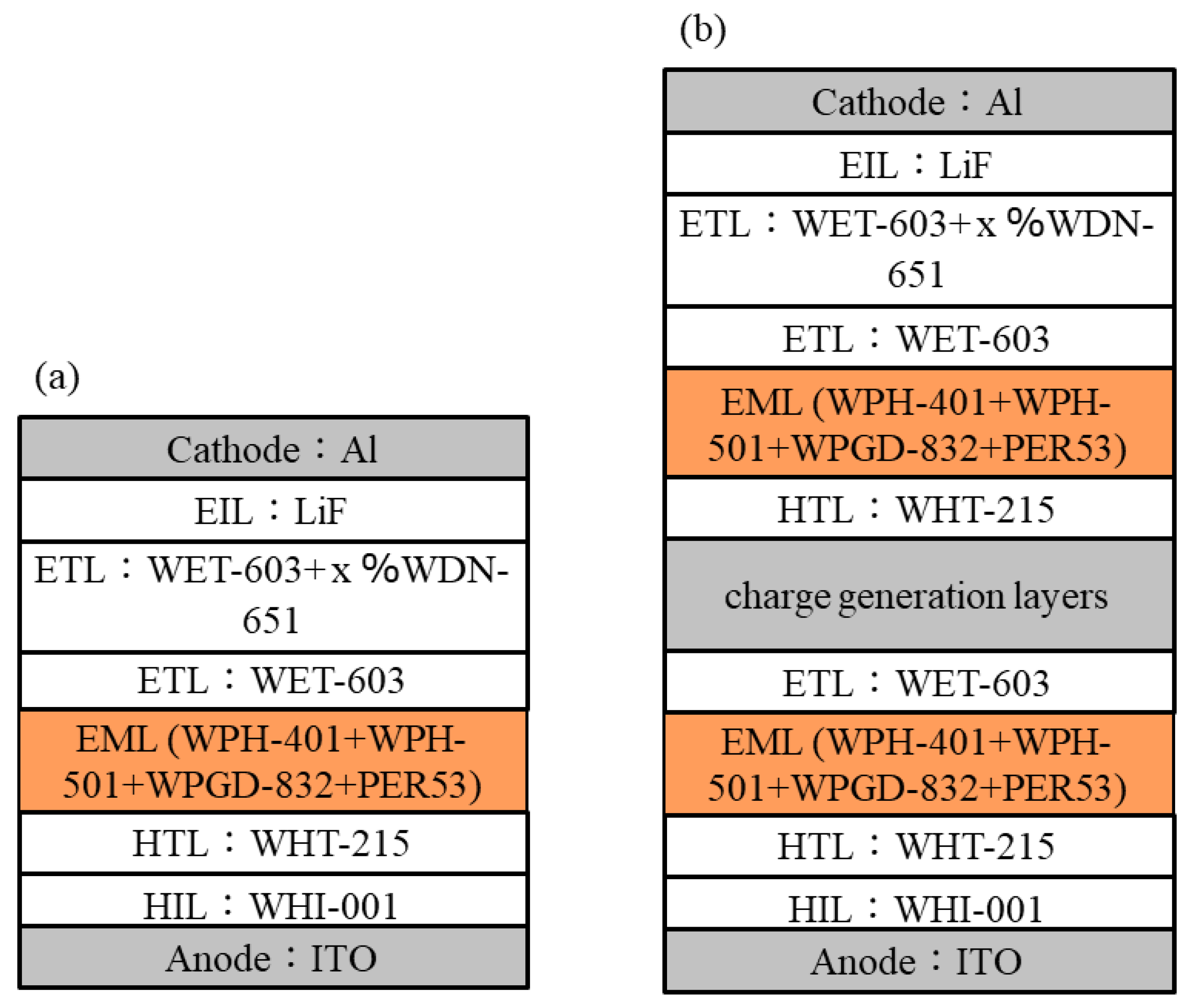
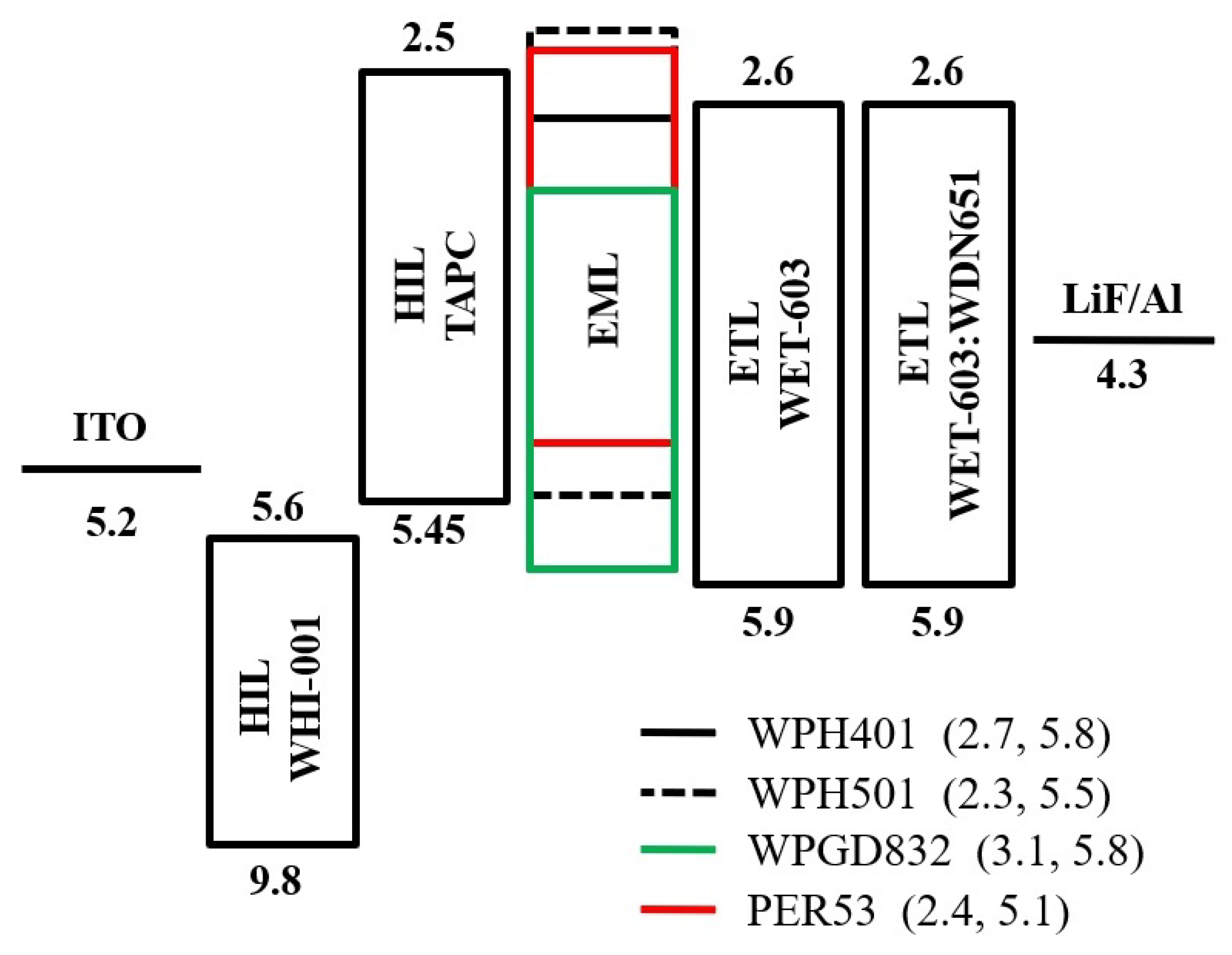
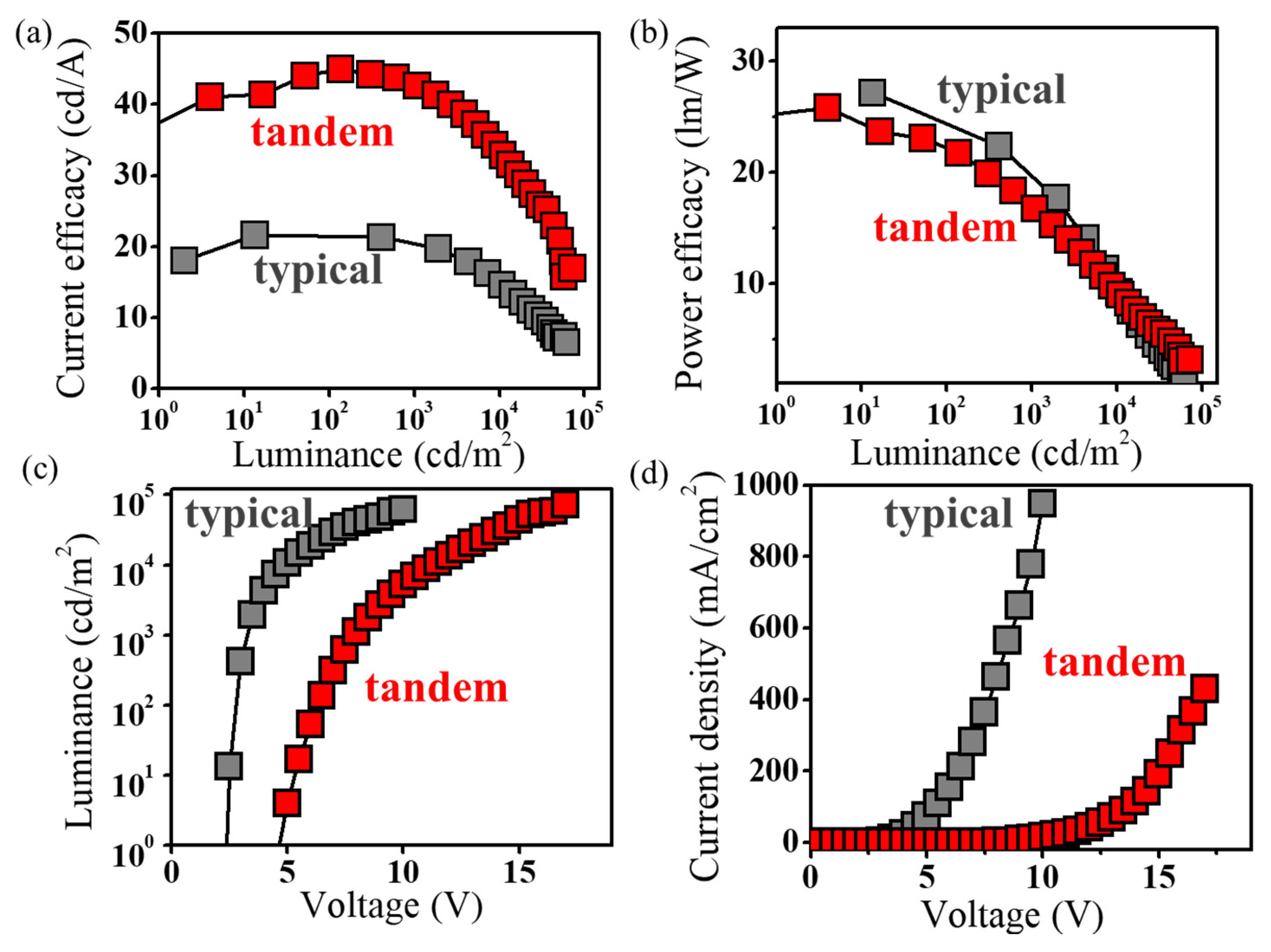
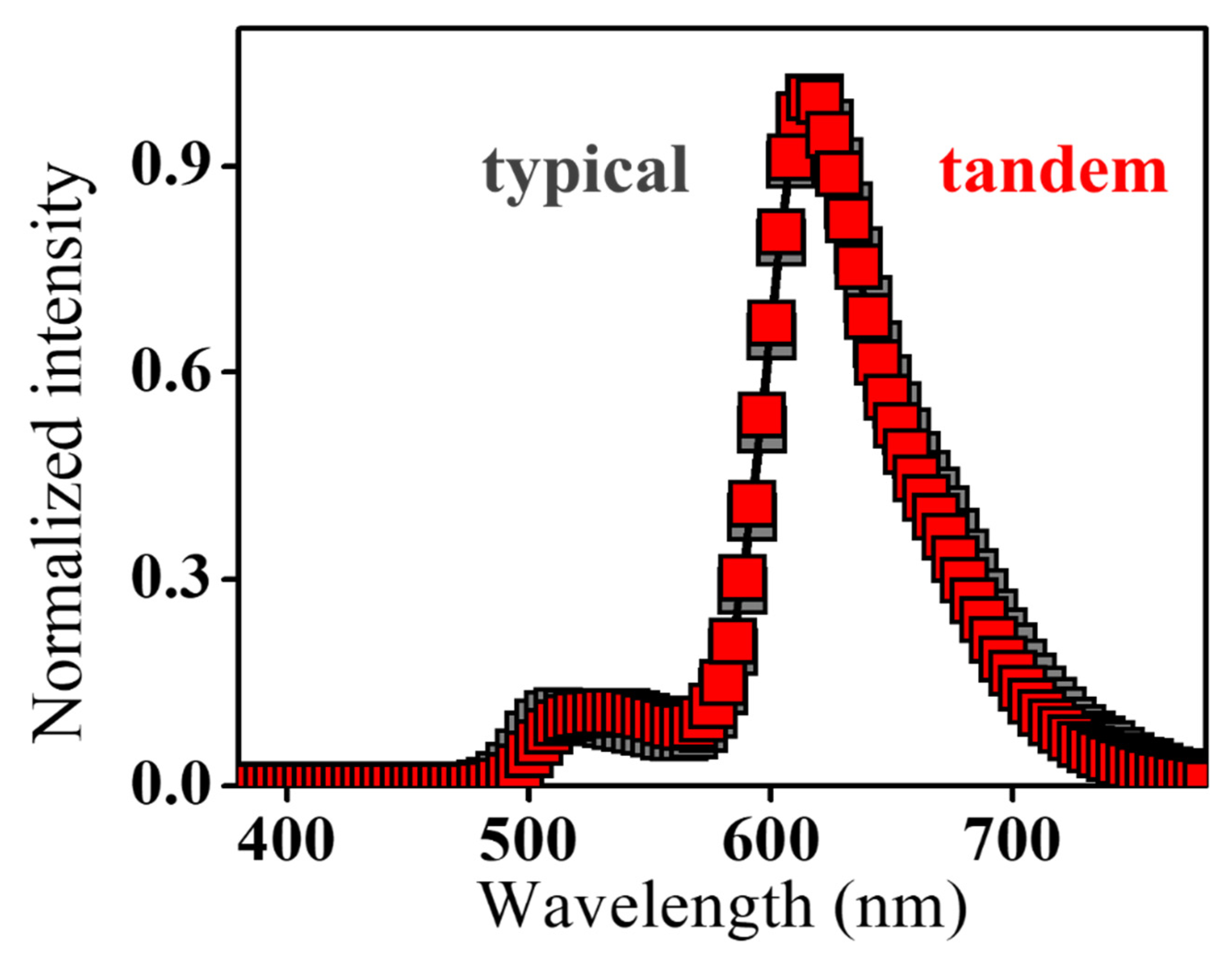
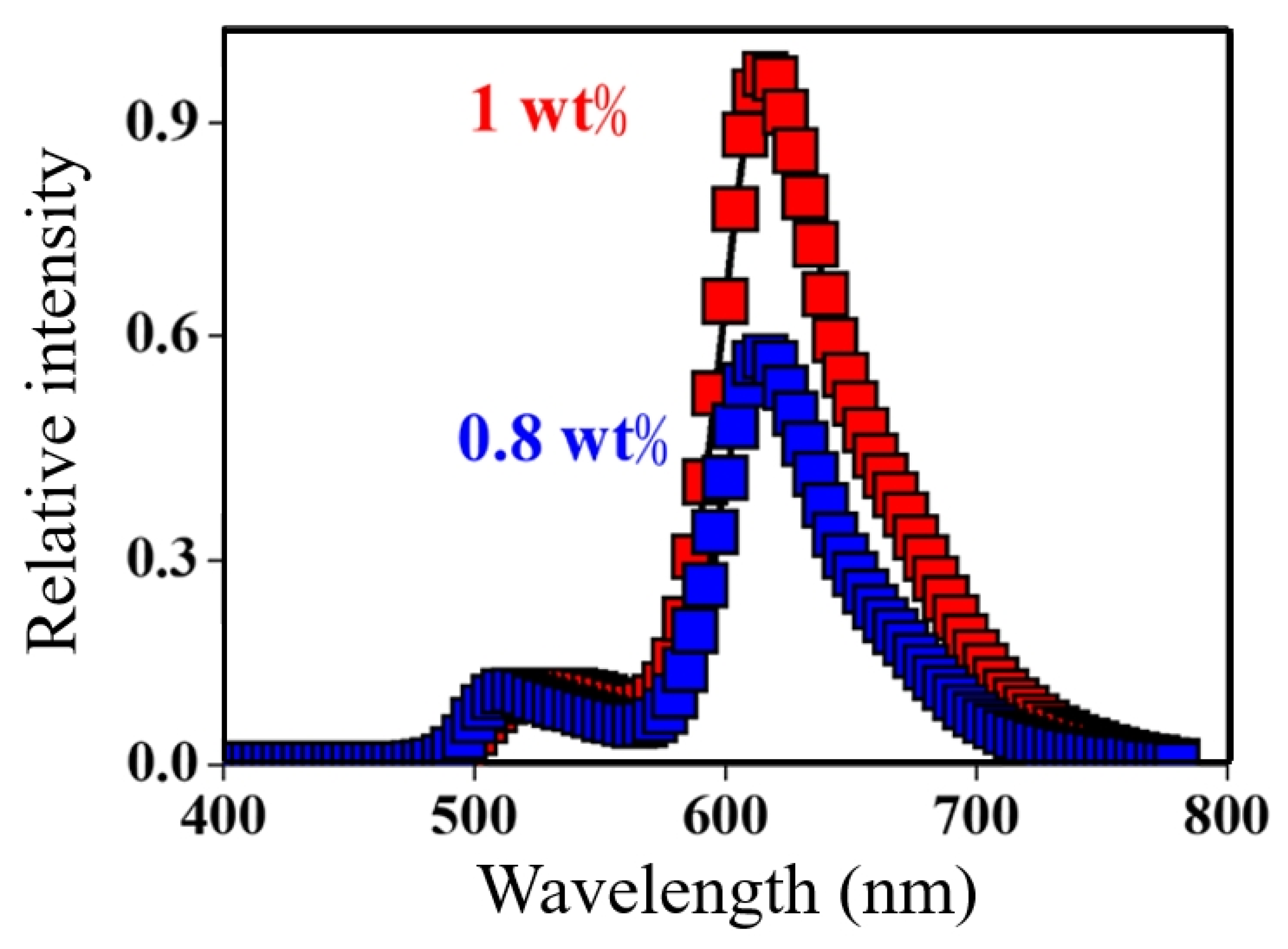
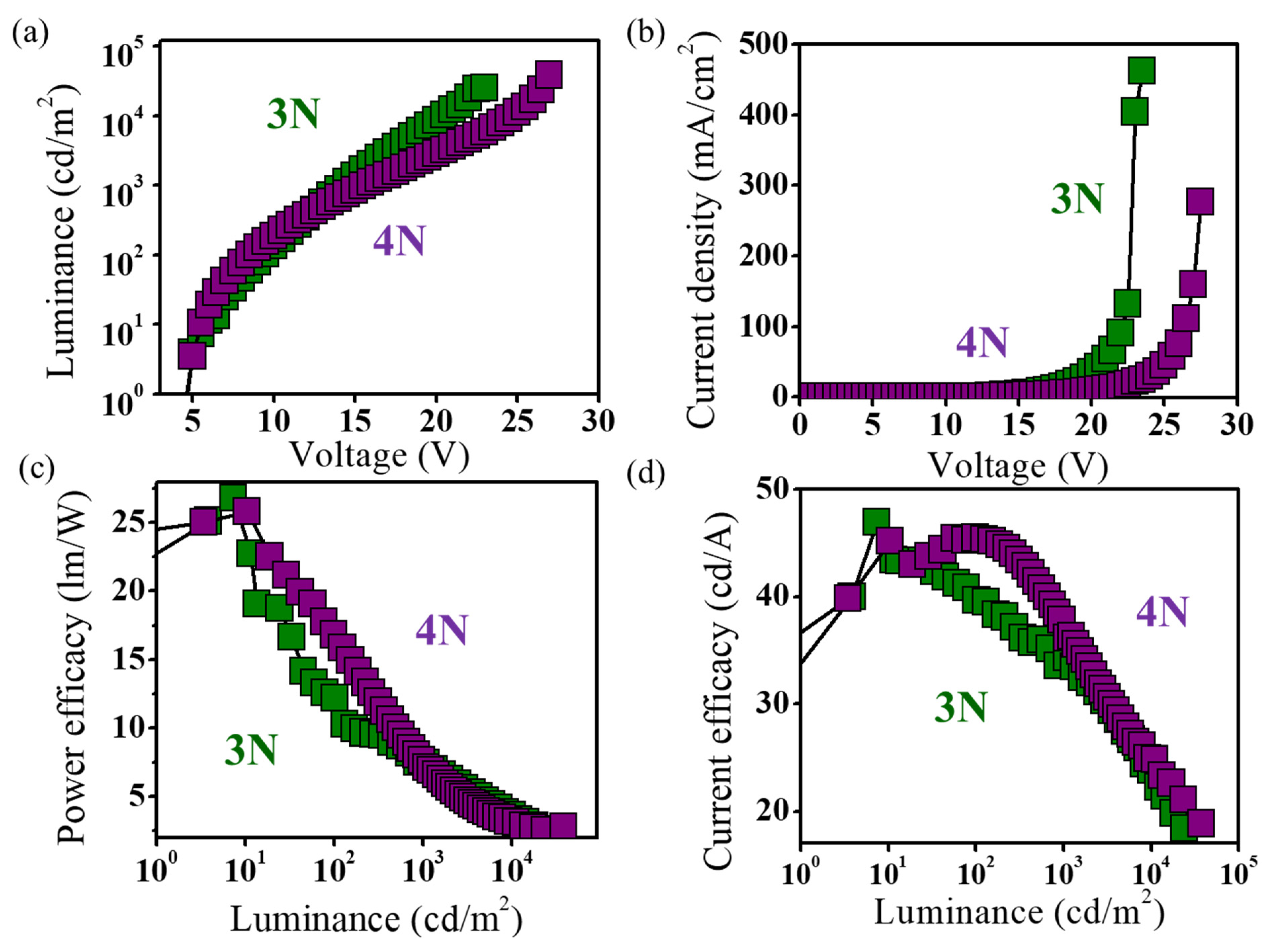
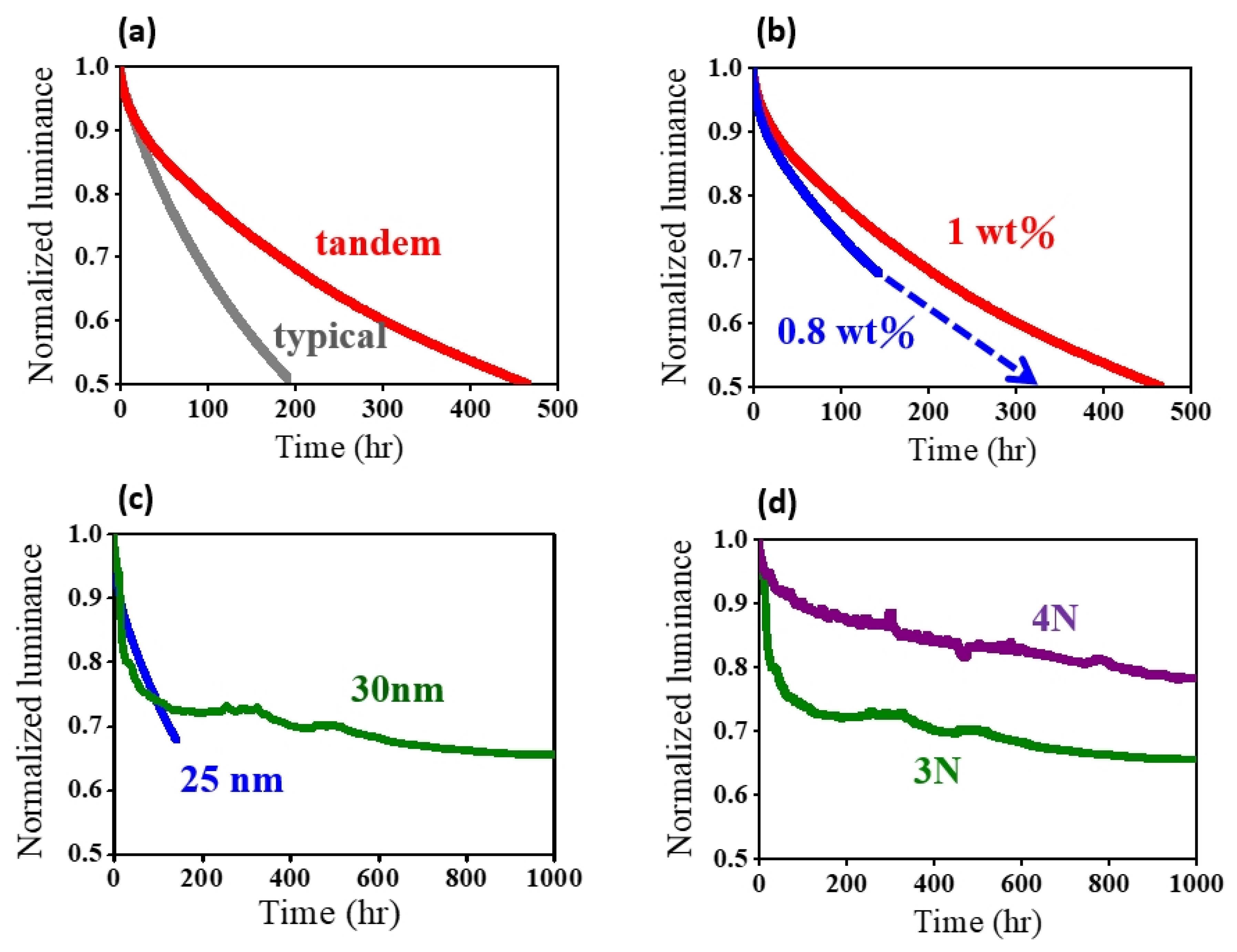
| Device Architecture | Doping Concentration (wt%) | OV [V] | PE [lm/W] | CE [cd/A] | EQE [%] | CIE (x, y) Chromatic Coordinates | Max Luminance (cd/m2) | Lifetime (h) @ 1000 cd/m2 |
|---|---|---|---|---|---|---|---|---|
| @ 100/1000/10,000 cd/m2 | ||||||||
| Typical | 1 wt% | 2.6/ 3.2/ 4.9 | 26.1/ 20.5/ 9.6 | 21.6/ 20.7/ 14.9 | 14.7/ 14.9/ 10.5 | (0.60, 0.38)/ (0.62, 0.38)/ (0.61, 0.38)/ | 61,000 | 10,000 |
| Tandem | 1 wt% | 6.3/ 7.9/ 11.3 | 22.3/ 17.0/ 9.3 | 44.6/ 42.8/ 33.5 | 28.9/ 28.6/ 22.4 | (0.61, 0.39)/ (0.61, 0.38)/ (0.61, 0.38)/ | 72,500 | 23,382 |
| Doping Concentration (wt%) | Emissive Layer Thickness (nm) | Purity of Green Dye | OV [V] | PE [lm/W] | CE [cd/A] | EQE [%] | CIE (x, y) Chromatic Coordinates | CRI | SRI | MPE (s) | MSS (%) | Lifetime (h) @ 1000 cd/m2 |
|---|---|---|---|---|---|---|---|---|---|---|---|---|
| @ 100/1000/10,000 cd/m2 | ||||||||||||
| 1 | 25 | 3N | 6.3/ 7.9/ 11.3 | 22.3/ 17.0/ 9.3 | 44.6/ 42.8/ 33.5 | 28.9/ 28.6/ 22.4 | (0.61, 0.39)/ (0.61, 0.38)/ (0.61, 0.39)/ | 85/ 84/ 85 | 76/ 75/ 77 | 14,969/ 15,403/ 14,862 | 1.6/ 1.5/ 1.5 | 23,382 |
| 0.8 | 25 | 3N | 5.6/ 7.2/ 10.5 | 21.3/ 16.7/ 8.8 | 37.6/ 38.1/ 29.5 | 22.0/ 22.7/ 17.6 | (0.58, 0.40)/ (0.59, 0.40)/ (0.58, 0.40)/ | 75/ 75/ 76 | 77/ 76/ 77 | 8,783/ 9,595/ 8,817 | 2.1/ 2.0/ 2.1 | 16,037 |
| 0.8 | 30 | 3N | 9.4/ 14.3/ 20.5 | 11.8/ 7.5/ 3.7 | 35.7/ 34.0/ 23.9 | 21.2/ 20.9/ 14.8 | (0.59, 0.40)/ (0.59, 0.40)/ (0.58, 0.41)/ | 78/ 77/ 76 | 77/ 78/ 79 | 10,802/ 10,106/ 7,685 | 1.9/ 2.0/ 2.3 | 223,500 |
| 0.8 | 30 | 4N | 8.5/ 15.6/ 24.7 | 16.8/ 7.5/ 3.2 | 45.5/ 37.4/ 24.8 | 27.6/ 22.7/ 14.9 | (0.60, 0.39)/ (0.59, 0.40)/ (0.57, 0.41)/ | 80/ 80/ 80 | 77/ 78/ 78 | 12,306/ 11,025/ 10,708 | 1.7/ 1.8/ 1.8 | >223,500 |
Disclaimer/Publisher’s Note: The statements, opinions and data contained in all publications are solely those of the individual author(s) and contributor(s) and not of MDPI and/or the editor(s). MDPI and/or the editor(s) disclaim responsibility for any injury to people or property resulting from any ideas, methods, instructions or products referred to in the content. |
© 2023 by the authors. Licensee MDPI, Basel, Switzerland. This article is an open access article distributed under the terms and conditions of the Creative Commons Attribution (CC BY) license (https://creativecommons.org/licenses/by/4.0/).
Share and Cite
Jou, J.-H.; Lin, W.-J.; Shih, S.-H.; Wang, Y.-S.; Sahoo, S.; Singh, M.; Tsai, Y.-C.; Wen, S.-W. Blue-Hazard-Free Organic Light-Emitting Diode with a Lifetime Greater than 200,000 h. Electronics 2023, 12, 2099. https://doi.org/10.3390/electronics12092099
Jou J-H, Lin W-J, Shih S-H, Wang Y-S, Sahoo S, Singh M, Tsai Y-C, Wen S-W. Blue-Hazard-Free Organic Light-Emitting Diode with a Lifetime Greater than 200,000 h. Electronics. 2023; 12(9):2099. https://doi.org/10.3390/electronics12092099
Chicago/Turabian StyleJou, Jwo-Huei, Wen-Jun Lin, Sheng-Hsu Shih, Yi-Siang Wang, Snehasis Sahoo, Meenu Singh, Yung-Cheng Tsai, and Shih-Wen Wen. 2023. "Blue-Hazard-Free Organic Light-Emitting Diode with a Lifetime Greater than 200,000 h" Electronics 12, no. 9: 2099. https://doi.org/10.3390/electronics12092099
APA StyleJou, J.-H., Lin, W.-J., Shih, S.-H., Wang, Y.-S., Sahoo, S., Singh, M., Tsai, Y.-C., & Wen, S.-W. (2023). Blue-Hazard-Free Organic Light-Emitting Diode with a Lifetime Greater than 200,000 h. Electronics, 12(9), 2099. https://doi.org/10.3390/electronics12092099







